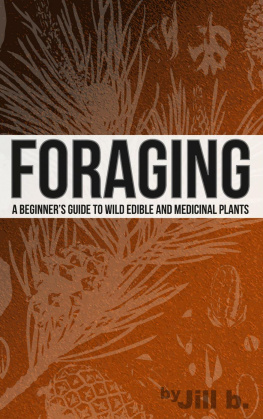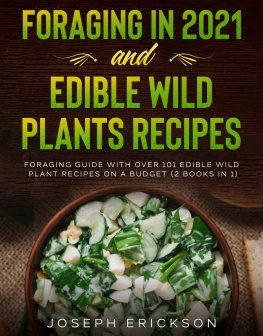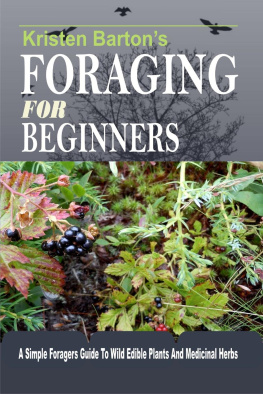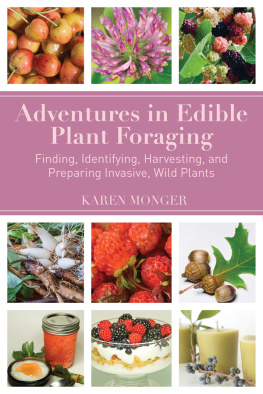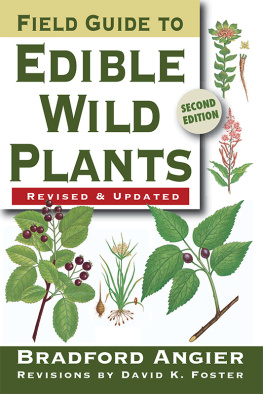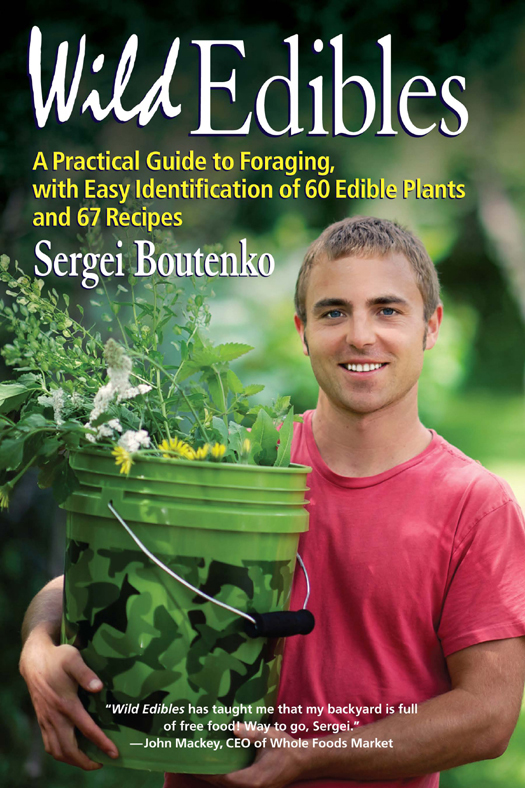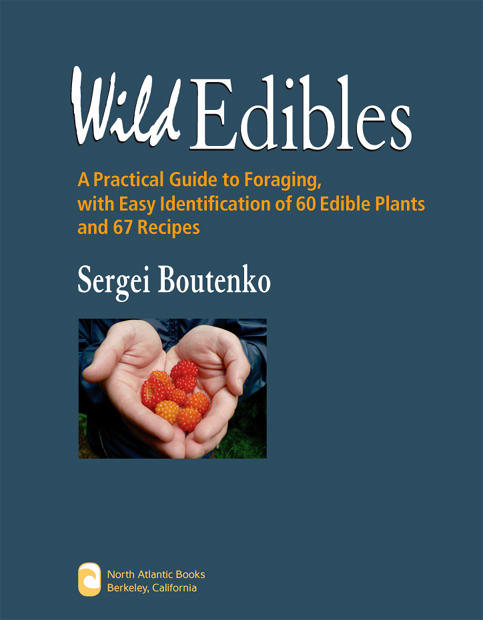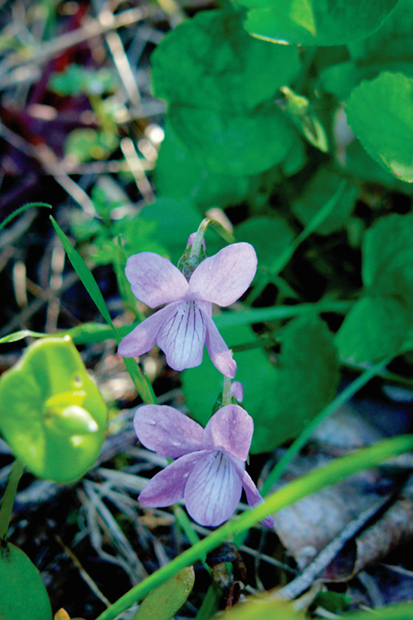Wild Edibles
Also by Sergei Boutenko
Fresh: The Ultimate Live-Food Cookbook
(with Valya Boutenko)
The Miracle of Greens: How Greens and Wild Edibles
Can Save Your Life (DVD)
Wild Edibles, an iPhone application, is available
through the iTunes store.
eISBN: 978-1-58394-627-5
Copyright 2013 by Sergei Boutenko. All rights reserved. No portion of this book, except for brief reviews, may be reproduced, stored in a retrieval system, or transmitted in any form or by any meanselectronic, mechanical, photocopying, recording, or otherwisewithout the written permission of the publisher. For information contact North Atlantic Books.
Published by
North Atlantic Books
P.O. Box 12327
Berkeley, California 94712 | by Nicole Slater
(www.NicoleSlaterPhotography.com).
Photo on .
Except where noted, all interior photos are by the author. |
Cover design by Brad Greene.
MEDICAL DISCLAIMER: The following information is intended for general information purposes only. Individuals should always see their health care provider before administering any suggestions made in this book. Any application of the material set forth in the following pages is at the readers discretion and is his or her sole responsibility.
Wild Edibles: A Practical Guide to Foraging, with Easy Identification of 60 Edible Plants and 67 Recipes is sponsored by the Society for the Study of Native Arts and Sciences, a nonprofit educational corporation whose goals are to develop an educational and cross-cultural perspective linking various scientific, social, and artistic fields; to nurture a holistic view of arts, sciences, humanities, and healing; and to publish and distribute literature on the relationship of mind, body, and nature.
North Atlantic Books publications are available through most bookstores. For further information, visit our website at www.northatlanticbooks.com or call 800-733-3000.
The Library of Congress has cataloged the printed edition as follows:
Boutenko, Sergei.
Wild edibles : a practical guide to foraging, with easy identification of 60 edible plants and 67 recipes / Sergei Boutenko.
pages cm
Includes bibliographical references.
Summary: This practical guide to plant foraging provides readers with the tools to safely identify, harvest, and prepare wild edible plants and enjoy the health and economic benefits of eating wildProvided by publisher.
1. Wild plants, EdibleIdentification. 2. Cooking (Wild foods) I. Title.
QK98.5.A1B68 2013
641.303dc23
2012043040
v3.1

For the wildly adventurous and the playfully rebellious.
Disclaimer
I dentification and use of wild plants requires particular care and attention. Never eat any plant unless you are absolutely sure that it is edible. Carefully read the introduction to wild edibles in this book prior to harvesting the plants discussed. The information in this book is for educational purposes only. It is not intended as a substitute for medical advice, diagnosis, or treatment. The author and publisher and any of their counterparts assume no responsibility whatsoever for any adverse effects encountered by the individual. Because of food allergies, any person may experience a reaction to a plant that is known to be safe. By choosing to consume unfamiliar, new foods, the reader agrees to assume all risks and responsibilities. Please harvest wild edibles with care!
We live in a society that loves guarantees. In the field of foraging, however, nothing is 100 percent certain. The topic of wild edibles is one of controversy. There are many expert opinions about how foragers should conduct themselves, and often these experts contradict one another. In writing this book, I will likely share viewpoints that will disagree with others. The information in this book comes from countless hours of my own research and years of experimentation in the field. I believe in it wholeheartedly, but it is still largely my opinion. I urge you to question my words and develop your own protocol for how you forage. There are definite risks you will encounter when harvesting and eating wild food, but life is full of risks, and the benefits of edible flora greatly outweigh the dangers. I approve the message in this book and support readers who want to incorporate natures gifts into their lifestyle.
Acknowledgments
F irst and foremost, I would like to thank my parents for going against the grain and providing me with a first-class alternative education. Though my upbringing was intense at times, it has shaped me as the man I am today. Mom, you were right when you said, Youll thank me later. Thank you! I am grateful to my sister, who, though younger than I am in years, provides me with a constant stream of much-appreciated wisdom. I would also like to thank Nicole Slater for supplying me with professional photographs and Jessica Musicar, Jennifer Eastman, and Jessica Moll for helping edit my book. Last but not least, I am grateful to all my friends who devoted their time and expertise to further improve this book, especially Stella Copeland, who gave me professional botanist feedback.
Contents
Introduction

I t was a cold morning in mid-April when we ran out of food. We sat on tree stumps at four thousand feet above sea level and watched as Mom rummaged through our shabby backpacks in search of something edible. After several minutes, she managed to round up a half-empty bottle of olive oil, several handfuls of rolled oats, a few cloves of garlic, and a small container of sea salt. We were four days into our journey and had to hike another fifty miles to collect our next food parcel in the closest middle-of-nowhere town in Southern California.
Earlier that year, in January of 1998, my parents decided that as part of our adventurous lifestyle and home-schooling experience, we would hike the entire Pacific Crest Trail, which stretches from Mexico to Canada along the West Coast. Our team consisted of my mom, dad, sister, cousin (who was visiting from Russia for a year to get a well-rounded American experience), and me. None of us had hiked much, but what we lacked in practice we made up for in drive. My mother spearheaded the idea of a six-month, 2,650-mile walk after she read a book about the adventures one thru-hiker had on the Appalachian Trail. She decided on the Pacific Crest Trail because it was more wild and had less traffic than its East Coast sibling. At first my father was not too keen on such a long trek, but my moms determination quickly appealed to his adventurous side and he fell in line. There is a saying in Russia, The man is the head of the family, while the woman is the neck, and the head cannot turn without the neck. As the neck, my mother steered our Chevy Astro van into a parking lot in front of a Play It Again Sports store in Escondido, California. There we equipped ourselves with top-of-the-line used backpacking gear in preparation for the journey ahead.


